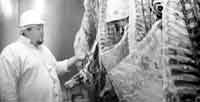Cuttin' it up
Animal Science class shows students steps involved in meat production
By RORY VAN LOON
Attention Fresno State students: the Animal Science and Agriculture Education Department has a class that many probably are not aware even exists.

Senior Ryan Clark said there are student contests on who makes the best cut. Photo by Cole Davis |
Animal Science 171, also known as Meat Science, is a lecture and lab class that deals with the step-by-step procedures of meat production.
The labs are hands-on activities that deal with three different types of meat during the semester.
The three types of meat consist of mutton, beef, and pork.
The class, taught by John Henson, deals with the cutting, grinding, packaging and cooking of various types of meat. Animal Science 171 students are taught to observe the different qualities of a particular meat product; they are able to detect the quality by color, moisture, marbling and flavor.
The Meat Lab and many of the classes related to it have had some negative interactions with such animal rights groups as PETA, said Heston Nunes, an animal science major.
The agriculture department is afraid that negative exposure can only add to the distorted perception the animal rights groups are trying to get across, Nunes said.
Nunes admits it is hard to judge something that people do not know about, so he said he hopes educating people on Animal Science 171 may shed some light on some misconceptions about the class.
The labs consist of a four-week process for each type of meat.
The first week of lab consists of the slaughtering, otherwise known as harvesting, of the animal.
Certified student employees in the meat lab do the harvesting procedure; John Amparan, a graduate student currently pursuing his MBA, is the meat technician in charge of the meat lab.
The students of Animal Science 171 can choose not to be present during the procedure. During this procedure, hard hats, hairnets, gloves, aprons and other safety and hygiene gear are used. USDA inspectors are also present.
The hide is then taken off and the carcass is chilled.
The following week, the carcass is removed from the cooler. The lab then splits the carcass and breaks it down into sections. The slicing of the portions depends upon the order requested before the procedure begins.
During this week’s procedure, students are able to study the muscle structure of the animals. The students observe the different muscles and how those muscles contract and relax.
The third week of the Meat Science Lab consists of the hands-on experience of making the product.
The animal science students are able to make hamburgers, roast, sausage, hot dogs and pork chops.
After the students complete the product, they package the meat to give to the selected buyer or buyers.
The fourth and final week of that specific meat product is spent touring meat-packaging plants.
The class also teaches the students the correct procedures of meat storage, preservation and thawing.
Students are taught the different types of rigor mortis and the correct safety, and hygiene procedures necessary when handling the raw meats involved.
The class meets on Mondays and Wednesdays of each week for lecture; the lab is on Thursdays.
Unfortunately for students interested in taking this class next semester, Animal Science 171 will not be available.
|

